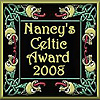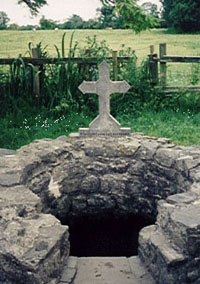| |

Traditions, folklore, history and more. If it's Irish, it's here. Or will be!
"People will not look forward to posterity who never look backward to their ancestors."
-Edmund Burke




Quotes
Library: Books, Movies, Music
Prints & Photos
Poetry
Jokes


Shops Ireland
Bunús na Gaeilge
(Basic Irish)
Circle of Prayer
Blessings
Did You Know?
Himself/Herself
Write to Us
Readers Write..
Links/Link to Us
Advertise with us
Awards & Testimonials
Submissions Guide


|
|
|
 Pattern Day in Old Ireland Pattern Day in Old Ireland
by Bridget Haggerty
The word pattern is derived from the Irish Patrun or English Patron and, in the old days, most Irish parishes had a patron saint. On the saint's feast day, the parishioners celebrated what was known as a Pattern Day.
In pre-Reformation times, the festivities began with religious devotions at the church, but this came to an end when the confiscation and/or destruction of Roman Catholic churches took place in the century and a half between the 1540s and the 1690s. By 1700, the devastation was such that very few, if any, churches remained under Catholic control and public religious ceremonies almost disappeared.
With the central location of their secular devotions gone, the faithful found alternative ways to celebrate their saint's feast day. While many of the laity paid homage at the saint's shrine or in the ruins of their local church, most devotions took place at the holy well.
In general, devotions at these sacred wells began with making what was called 'the rounds.' The people would walk around the well a certain number of times while saying special prayers. Part of the ritual included drinking the water as well as bathing with it. It was said that water from a sacred well had curative powers and some wells became famous for curing specific ailments. At the end of their visit, the people usually left behind a small token - some coins, a piece of cloth which was hung up, or any other small object they happened to have with them.
These sacred well traditions, rituals, legends and customs date back hundreds of years, and were common throughout the British Isles long before Christianity came to Ireland. However, for Irish Catholics, the disappearance of their churches and the Penal Laws made well-gatherings an important event - especially on the feast day of their patron saint.
Without official clerical direction, Pattern Days became noted for unorthodox forms of devotion and often rowdy amusements. The clergy tried to keep matters under control and at the Synod of Tuam in 1660, the following decree was announced:
"Dancing, flute-playing, bands of music, riotous revels and other abuses in visiting wells and other holy places are forbidden...."
Of course, no-one paid much attention to that decree or even the Penal Laws of the early 18th century which included the following infamous 'Act to prevent further Growth of Popery." It prohibited "the riotous and assembling together of many thousands of papists to the said wells and other places and prescribing a fine of 10/- on all who met at wells and 20/- on vendors of 'all ale, victuals or other commodities' with a public flogging in default of payment, enjoined on all magistrates the demolition of 'all crosses, pictures and inscriptions that are anywhere publickly set up, and are the occasion of any popish superstitions."
While this law caused the destruction of most embellishments at wells and shrines, it was ineffective in suppressing Pattern Days because it depended on the local gentry for enforcement. While there were a few religious bigots who enjoyed making life miserable for the faithful, most of the gentry turned a blind eye on what was, for the most part, a harmless local custom. Thus, Pattern Days continued to flourish on into the 19th century.
In Thomas Croften Croker's "Researches in the South of Ireland," he gives a detailed description of the revels during a Pattern Day in Gougane Barra. The year was 1813:
"After having satisfied our mental craving, we felt it necessary to attend to our bodily appetites, and for this purpose adjourned to a tent where some tempting slices of curdy Kerry salmon had attracted our notice. In this tent, with the exception of almost half an hour, we remained located from half-past seven in the evening, until two o'clock the following morning, when we took our departure from Cork.
After discussing the merits of this salmon, and washing it down with some of "Beamish & Crawford's Porter" we whiled away the time by drinking whiskey-punch, observing the dancing to an excellent piper, and listening to the songs and story-telling which were going on about us.
As night closed in, the tent became crowded almost to suffocation, and dancing being out of the question, our piper left us for some other station, and a man, who I learned had served in the Kerry militia, and had been flogged at Tralee about five years before as a White-boy, began to take a prominent part in entertaining the assembly by singing Irish songs in a loud and effective voice. These songs were received with shouts of applause, and as I was then ignorant of the Irish language and anxious to know the meaning of what had elicited so much popular approbation, I applied to an old woman near who I sat, for an explanation or translation, which she readily gave me, and I found that these songs were rebellious in the highest degree. Poor old King George was execrated without mercy; curses were also dealt out wholesale on the Saxon oppressors of Banna the Blessed (an allegorical name for Ireland); Bonaparte's achievement were extolled, and Irishmen were called upon to follow the example of the French people."
While the clergy and then the Penal Laws did everything to suppress Patron Day celebrations, it was the great Famine that caused the custom to almost die out. In his book of 1849, "Popular Irish Superstitions," Sir William Wilde paints a bleak picture of the land and the culture at that time:
"The old forms, and customs too, are becoming obliterated. The festivals are unobserved and the rustic festivities neglected or forgotten - the bowlings, the cakes, the prinkums,* do not often take place when starvation and pestilence stalk over a country, many parts of which appear as if a destroying army had but recently passed through it. Such is the desolation which whole districts, of Connaught at least, at this moment presents. Entire villages being levelled to the ground; fences broken; the land untilled and often unstocked, and miles of country lying idle and unproductive, without the face of a human being to be seen upon it."
After the Famine, other developments served to suppress old customs and traditions. During the Victorian era, what was left of the Catholic laity slowly began to regain middle-class status. It was a time when Victorian "respectability" assumed the sanctity of moral law and many of the old customs were discouraged or forbidden because they offended the sanctimonious.
Even more distressing to this writer was learning that many Catholics began to borrow the code of acceptable behavior from their Protestant neighbors who were not merely largely puritan, but also out of touch with the manners and modes of the country folk.
In general, many of the people who survived the Famine and stayed in Ireland, chose to put as much distance between themselves and the old ways as they could. This was also true of the masses who emigrated to America, Australia and other countries throughout the world. And, succeeding generations have continued to distance themselves from what was once perceived as the old-fashioned ways of a poor, down-trodden and ignorant country.
Thus, in the course of a few hundred years, much of the gaiety of traditional rural life is gone. A sad fact that. However, with the resurgence of interest in all things Irish, combined with the confidence of a country celebrating the economic power and teeth of the Celtic Tiger, there is a renewed pride in our history and heritage. That said,
will we see the resurrection of Pattern Days? Probably not. But, we still have Puck Fair, the MatchMaker Festival in Lisdoonvarna, and many other celebrations steeped in the old traditions.
More importantly, as we learn as much as we can about old Ireland's culture and customs, the intention is to share the knowledge so that in a small way, we can help preserve the legacy of our ancestors for future generations.
*Prinkums were peasant balls
Resources: The Year in Ireland by Kevin Danaher
Image: St. Brigid's Well, County Clare.
|
|
Fri, Sep 27, 2024
 The Galway Hooker The Galway Hooker
This unique vessel, with its distinctive curved lines and bright red sails, originated in the village of Claddagh. During the 19th century, hookers supported a significant fishing industry and also carried goods, livestock and fuel. Seán Rainey is remembered for building the last of the original boats, the Truelight, for Martin Oliver who was to become the last king of the Claddagh; as king, he was entitled to white sails on his boat. Since the mid seventies, many of the old sailing craft which were on the verge of extinction have been lovingly restored and new ones have been built. During the summer months they can be seen at festivals such a Cruinniú na mBád - the Gathering of the Boats - in Kinvara.
Click for More Culture Corner.
This great classic of Irish folklore is one of Bridget's "bibles."
In his warm, easy-going style, we are introduced to the old ways if life; we learn how a roof is thatched, what the people wore, what they ate and drank (inluding a whole chapter devoted to mountain dew), the importance of the dairy, the customs associated with weddings and wakes, how young people were educated, and more.. It's fascinating and absorbing reading - and once you get started, it's difficult to put down.
Click here for Ireland Long Ago.
|
Through the words of West Ireland story tellers,we are drawn into the lives of coopers, thatchers, farriers, and weavers. An elegy to the loss of traditional life in the west of Ireland, the book details the region's vanishing communities and landscape with deep reverence and precision.
Amazon Review
Click for Notes from the West of Ireland
|
|
|
|
|




 The Galway Hooker
The Galway Hooker